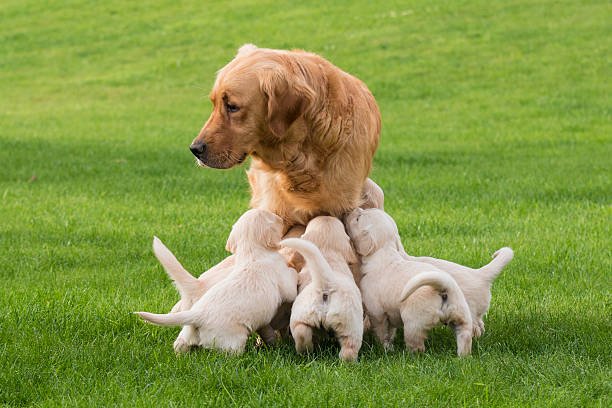We're an affiliate
We hope you love the products we recommend! Just so you know, we may collect a share of sales or other compensation from the links on this page at no additional cost to you. Thank you if you use our links, we really appreciate it!
If you already own a Golden Retriever and planning on getting another one as its mate, the following qualifications might have already crossed your mind: size, exceptional physical attributes, behavior, and pedigree.
Understanding your Goldies’ litter size helps you as an owner in monitoring the length of its gestation. It will give you time to prepare the necessary precautions as they enter the parturition and lactation period.
Determining your dog’s exact litter size is only possible a few days before whelping through a radiograph. But if you already want to have an idea of your Goldies’ litter size, fret not, as your dog’s litter size is influenced by several factors.
In this post, we will be tackling how many puppies Golden Retrievers can have, what factors can influence the litter size, their pregnancy, and breeding considerations.
Factors Affecting Golden Retriever Litter Size
Genetics of the Parents
Based on research, genetics can influence a dog’s litter by 15-20%. That is a big number to consider when it comes to selecting the parents for breeding. Dams usually have a bigger influence on the litter size rather than the sire.

Now, as mentioned, Goldies are selectively bred to obtain the desired traits and attributes. In some cases, breeders perform inbreeding to lock in these traits. However, inbreeding results in a negative effect on your Goldie’s litter size – it reduces the number of puppies in a litter.
Inbreeding may help you achieve the desirable traits you want your Goldie to have, but it will also compromise their health and their capacity to adapt to environmental changes and stress.
Therefore, it is best to diversify their genetics by selecting parents with exceptional traits that are far related to each other. Genetic diversity will still arise in acquiring the desirable traits, attributes, and behavior you want their litter to have.
Diversifying their genetics reduces their chances of acquiring genetic-related health conditions and allows survival in undesirable environmental changes.
Breed
It goes without saying, but the larger the breed, the larger the litter size will be. That is because medium to large dog breeds can carry more puppies inside their womb. Golden Retrievers, as medium-sized breeds, produce an average range of 5-12 puppies in one litter.
One veterinary concept that is seldom used (as it may not always be applicable) is that determining the number of puppies in a litter can be based on the number of teats or nipples a female dog has.
If Golden Retrievers have about 4-6 pairs of nipples (8-12 in total), their probable litter size is about half of the number of teats they have, which is 7 or 8. But then again, there is always an exception to the rules. It may not always be applicable as some Goldies may produce less than 6 puppies.
Age of the Mother
Golden Retrievers pregnant at first heat or within 6-9 months may not guarantee a healthy and large litter size. The size and weight of young Goldies are not yet suitable for pregnancy.
Growing puppies inside a young Goldie’s womb may not allow for adequate nutrient absorption as the mother is still growing too. Fetal resorption, pre-mature birth, weak puppies, or small litter size are possible results of early pregnancy.
Additionally, older females produce smaller litters and have a higher frequency of neonatal losses. In some reported cases, the mammary glands of older females slow down in milk production, resulting in breastfeeding complications.
Health of the Mother
Maternal health is an important indicator in determining the success of pregnancy and the health and well-being of the puppies up until the period of lactation and weaning. A healthy mother ensures a healthy litter of puppies.
However, certain conditions will affect the mother’s health, such as existing infections, reproductive disorders, a stressful environment, and proper nutrition.
Nutrition of the Mother
Pregnant and lactating Goldies will require a lot of high-caloric diets to support both the mother and large litter size. If proper nutrition is not provided, malnourished Goldies may result in weak, underweight, and small litter sizes.
The risk of having congenital defects during pregnancy is high, and the development of neonatal problems may arise, resulting in the death of puppies in a litter.
What is the Average Litter Size of Golden Retrievers?
Statistics and Studies on the Average Litter Size
Although no official studies have been conducted regarding a Golden Retrievers’ litter size, based on retrospective sources recorded online, the average litter size for Golden Retrievers is about 7-8 puppies, with 17 puppies being the largest and 1 puppy being the smallest litter produced.

Provided with that information, we can assume that the litter size of Golden Retrievers is somewhat unpredictable due to several factors affecting it. But it is safe to say that from a range of 1 to 17 puppies, they can produce an average range of 5 to 8 puppies.
Comparison with Other Dog Breeds
Unlike small dog breeds, which are not expected to have more than 5-6 puppies in one litter, it is easier to predict their litter size compared to medium to large breeds. Some large breeds may surprise us with more than the expected maximum number of puppies they can produce.
Tia, a Neapolitan Mastiff, had the largest record of 24 puppies in one litter on November 29th, 2004, as declared by the Guinness World Records. The litter was delivered via cesarean section with a total of 9 females and 15 males.
The litter of 24 puppies did not survive altogether as 1 puppy was stillborn, and the other 3 puppies died during the first week.
Some retrospective studies show that delivering puppies via elective C-section may improve the litter’s survival by 2%.
For some breeds like brachycephalic dogs, elective C-section is the best option to deliver their puppies to avoid damage to both the puppies and the dam’s birth canal.
However, this may not always be applicable since Golden Retrievers are known for their natural birthing method.
This claim is somewhat biased as it did not consider other factors like breed considerations, long-term survival risk of the puppies, and the complications it might cause to the dam.
Maximum and Minimum Golden Retriever Litter Sizes
Factors Affecting the Maximum and Minimum Litter Sizes
First-time Mothers
If your Golden Retriever is a first-time mom, you may expect an average litter size of 8 or below average but not less than 5. It is normal for them to bear the average number during their first pregnancy as they have just reached their full growth at 16 to 18 months.
But if your Goldie is bred and pregnant at 6-9 months, you may expect a smaller litter size than the average as their body is not fully prepared to carry out the pregnancy. Eventually, as seen in most cases, the size of their litter will grow in their subsequent pregnancies.
Experienced Mothers
Experienced mothers, on the other hand, may reach a maximum of 17 puppies in one litter size. Although the average maximum is 12, your Goldie is capable of bearing 17 puppies in one litter.
That is because most experienced mothers grew in size as they went through several pregnancies. However, experienced mothers may reduce their capacity to accommodate the maximum number of puppies as they reach senior age.
The same concept also applies to male Goldies. You do not want to breed too young or too old males as their sperm quality has not reached its full potential or reduces over time as they age, accordingly.
As experienced mothers go through several pregnancies, obesity is one condition that you have to look out for. Overweight and obese female dogs may produce a smaller litter than the average and may experience ‘fading puppy syndrome’.
Examples of Exceptionally Large and Small litter
Based on an online source (not an official record), the largest litter a Golden Retriever ever produced in the year 2009 was about 17 puppies, having 1 stillborn pup. The smallest litter for Golden Retrievers appearing in online sources was 1 puppy.
Frequently Asked Questions
1. How many litters can a Golden Retriever have?
Golden Retrievers can produce a maximum of two litters in a year, provided that their heat cycle is every 4-6 months. Their average litter size ranges from 5-12 puppies, although they can produce more than 12 puppies in one litter.
2. What determines the number of puppies in a litter?
The breed is one of the contributing factors in determining the number of puppies in the litter size. Medium to large breeds produce an average of more than 5 puppies in one litter.
Their parity (the number of times a successful pregnancy has taken place) is also an important factor in determining their litter size.
In some reported cases, multiparous females tend to have a higher number of puppies in a litter as compared to primiparous ones.
3. How long is a Golden Retriever pregnant?
Golden Retrievers have a gestational period of 60-65 days, with an average of 63 days. Your Goldie’s age and litter size may contribute to the duration of their pregnancy.
Conclusion
By this time, we have already understood a Golden Retriever’s litter size and what factors may contribute to reaching its minimum and maximum number. We also have to keep in mind that breeding them consecutively may not be appropriate for the dam’s health.
As much as we want more puppies with the desirable traits and attributes, we also have to give time for the mother to recuperate from the previous pregnancy and lactation period. Carrying an average of 7-8 puppies plus milking them is not an easy job.
If you are planning on breeding your Goldies, it is best to keep them in their best shape and condition. Veterinary health care plays a vital role in preparing your Goldies before the breeding season.
Most veterinarians recommend an update on their vaccination and parasitic control. Internal parasites are transmitted to the puppies via milking, which is why an update in their deworming schedule can increase the chances of their litter size. Proper supplementation is also important for both dams and puppies.

Christine is a Doctor in Veterinary Medicine. As the in-house vet and writer for Furs'n'Paws, Christine shares her extensive knowledge and expertise on all things pet-related, with a particular focus on small animals such as dogs and cats. In addition, she runs her own clinic in the Philippines and volunteers at a local organization to help stray pets. Her commitment to animal health is evident in her writing style, which makes her an invaluable resource for pet owners and animal lovers.



No responses yet